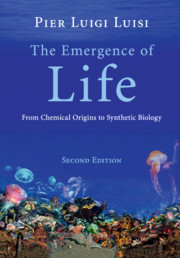Book contents
- Frontmatter
- Contents
- Acknowledgments
- Introduction
- Part I Approaches to the origin of life
- Part II What is life? The bio-logics of cellular life
- Part III Order and organization in biological systems
- 8 Self-organization
- 9 The notion of emergence
- 10 Self-replication and self-reproduction
- Part IV The world of vesicles
- Part V Towards the synthetic biology of minimal cells
- As a way of conclusion
- Appendix The open questions about the origin of life
- References
- Names index
- Subject index
10 - Self-replication and self-reproduction
from Part III - Order and organization in biological systems
Published online by Cambridge University Press: 05 September 2016
- Frontmatter
- Contents
- Acknowledgments
- Introduction
- Part I Approaches to the origin of life
- Part II What is life? The bio-logics of cellular life
- Part III Order and organization in biological systems
- 8 Self-organization
- 9 The notion of emergence
- 10 Self-replication and self-reproduction
- Part IV The world of vesicles
- Part V Towards the synthetic biology of minimal cells
- As a way of conclusion
- Appendix The open questions about the origin of life
- References
- Names index
- Subject index
Summary
Introduction
The combination of self-organization and emergence may give rise to a most important aspect of life: growth and reproduction. This is the property of a given structure to make copies of itself by assembling smaller parts taken from the environment, this assemblage being generally catalyzed by specialized catalysts. Thus, DNA does not reproduce itself alone, of course, what is needed in addition to the monomeric nucleotides is a good number of enzymes to make the process possible. However, it is the structure of DNA that possesses in its design the information to organize the process.
Let's start with a semantic note about the two terms, self-replication and self-reproduction. Although often treated synonymously, there is in fact a difference. Self-replication (the word comes from the Latin replica) means a faithful molecular copy, while self-reproduction refers rather to a statistical process of making very similar things. Thus, cells self-reproduce, while molecules self-replicate. It is not simply a semantic question, as according to Dyson (1985), self-reproduction processes, being less precise, may have started first in the early evolution and preceded self-replication processes, which require more complex control and editing.
Self-reproduction is rightly seen as the main motor for the development of life on Earth. Life unfolds in time by repetition patterns: one generation of dolphins gives rise to a new generation of dolphins; one family of roses gives rise to a new family of roses. This is a subtle, invisible multi-branched thread that links the present beings to all those that have existed before and to all those who will come. Looking back, everything condenses into the original cellular family, the whimsical LUCA (last universal common ancestor), which, by the way, should not be confused with the origin-of-life protocell, a much older event.
Self-replication and nonlinearity
There are some good reasons why, in the field of the origin of life, the emergence of self-reproduction is of such paramount importance. Before the implementation of self-replication, any interesting structure that might have originated in the prebiotic scenario would have decayed due to degenerative processes, and would have disappeared leaving no trace. Instead, with self-reproduction (as soon as the rate of self-reproduction is larger than the rate of decay), an increase in concentration of this structure would be possible.
- Type
- Chapter
- Information
- The Emergence of LifeFrom Chemical Origins to Synthetic Biology, pp. 247 - 262Publisher: Cambridge University PressPrint publication year: 2016



